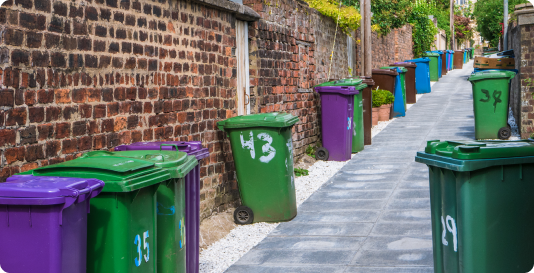Local authorities often use multiple solutions in an attempt to move forward with projects that help to reduce emissions and boost sustainability in waste collection. One system for route optimisation, a separate app for citizens, another system for in-cab technology, sensors from an external provider, and so on. This is more expensive and inefficient than necessary.
Implementing a comprehensive waste management system integrates various solutions, such as route optimisation, in-cab technology, smart bin sensors, and a citizen waste app, into a single platform. This not only streamlines waste collection processes, but also reduces the need for multiple software and systems, saving money and resources.
Here are 4 easy ways to improve sustainability in waste collection with WasteHero:
#1 Route Optimisation for Fuel Efficiency and Emission Reduction
Route optimisation is a key aspect of improving sustainability in waste collection. By using advanced routing algorithms, local authorities can design waste collection routes that are more efficient and reduce the environmental impact of waste collection.
Efficient routes reduce fuel consumption and emissions, as vehicles spend less time in traffic and make fewer unnecessary trips. This can also help minimise air pollution, as vehicles spend less time on the road and produce fewer emissions.
In addition to these benefits, efficient routes can also help increase the load factor of waste collection vehicles. This means that more waste can be collected on each trip, reducing the number of vehicles needed and further reducing fuel consumption and emissions.
#2 In-Cab Technology for Reducing Go-Backs
In-cab technology is a valuable tool for improving sustainability in waste collection. By equipping waste collection crews with digital in-cab technology, local authorities can enable drivers to follow optimised routes, track collections in real-time, and document missed collections.
Documenting missed collections helps prevent go-backs, where a vehicle returns to an area it has already collected from, saving fuel and reducing emissions. With a digital tool, printed route sheets are no longer necessary, helping to reduce paper usage and improve the overall efficiency of waste collection processes.
#3 Smart Bin Sensors for Dynamic Collection Schedules
Smart bin sensors can be a valuable tool for improving sustainability in waste collection. By attaching sensors to public bins, local authorities can collect bins on an as-needs basis, only collecting them when they are full. This agile approach can help reduce collection frequency by up to 40%, prevent overflowing bins, save fuel, reduce the usage of bin liners, and reduce emissions.
#4 Citizen Engagement For Improved Recycling Rates
Outside of regular features like collection calendars and lodging requests/complaints, a dedicated citizen waste app enables timely communications with residents, providing education on correctly sorting waste and providing collection reminders.
For example, the back office can automate messages to educate residents on incorrectly sorted waste as it happens. If a resident puts plastic in the wrong bin and the driver reports a ticket, the automation will send a notification to remind them to sort their waste correctly. This can help improve recycling rates, reduce contamination of waste streams, and reduce the amount of waste sent to landfills.
Implementing a comprehensive waste management system can help local authorities improve the sustainability of waste collection and reduce its environmental impact.
With WasteHero, you can easily optimise routes, equip crews with in-cab technology, collect public bins based on smart sensor data, and engage citizens with a dedicated app. Don’t miss out on the opportunity to improve sustainability and reduce your environmental impact.
If you’re a local authority looking to improve sustainability in waste collection, contact WasteHero to learn more.
[activecampaign form=16]




